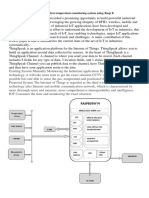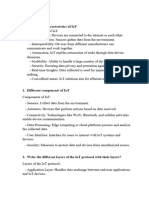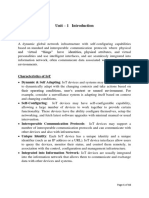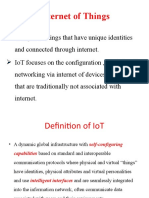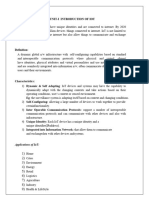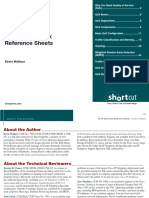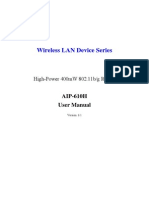IJERT Paper Template
IJERT Paper Template
Uploaded by
Nikhil PSCopyright:
Available Formats
IJERT Paper Template
IJERT Paper Template
Uploaded by
Nikhil PSOriginal Description:
Copyright
Available Formats
Share this document
Did you find this document useful?
Is this content inappropriate?
Copyright:
Available Formats
IJERT Paper Template
IJERT Paper Template
Uploaded by
Nikhil PSCopyright:
Available Formats
IOT Enabling Modular Wireless Controller Using
6LowPAN Technology
Nikhil PS
SELECT Dept, VIT University
Guided by : Dr.Prabhu KR, Praveen Hegde
AbstractInternet of things is the latest advancement
in the internet world which can connect millions of devices
to the network. This paper brings out 6LowPAN wireless
technology which enables energy efficient and long range
data transmission between motes and then connects to
internet through an edge router. The idea is to enable
internet connectivity to simple devices, using contiki os as
the operating system.
KeywordsInternet of things, 6LowPAN, Contiki OS
I.
INTRODUCTION
ipv6 enabled 6lowpan wireless technology. The ipv6 will
enable 128 bit address rather than 32 bit address of ipv4
which makes sure that we never run out of ip addresses
[4]. The data can be monitored and controlled using
smart phone mobile application if the phone have
internet service [2].
2.
PROPOSED
ARCHITECTURE
SYSTEM
AND
The Block diagram representation of the proposed
system is shown below in figure 1.
A. Overview
The internet of things can be defined as linking
everyday equipments like mobiles, washing machines,
televisions, sensors etc. to the internet world where it
can be intelligently controlled and monitored. It enables
various ways to establish communication between
devices and humans [1]. In the fast growing world of
Internet and communication innovation, our lives are
progressively driven to another dimension of enhanced
reality.
The importance of enabling IOT to the device has
become significant since last couple of years. According
to scientific research, 2 billion devices are expected to be
connected to the internet by the year 2021 at the rate of
36% increase per year. New wireless technologies are
being introduced to the market day by day and one
among the new intervention is the 6LowPAN wireless
technology, which introduces energy efficient and long
range communication, most suited for industrial
application [5].The 6lowPAN is the acronym for ipv6
low power wireless personal area network and the
concept was introduced with the idea of providing
internet protocol even to the smallest of devices.
B. Advantage of the iot enabling system
The sensor and actuator system are devices which we
come across daily and if the system can be controlled
remotely then it will be an added advantage for the
users. This proposed system enables IOT to the needed
products. The sensor data will be acquired from the
system and is packed as data frame ,which is then send
to the remote mote connected to the internet through
Figure 1
The system which we need to control and monitor
comprises of sensors and actuators. The devices like
washing machine, air conditioners, lighting systems can
be considered as the system mentioned here. The sensors
like light sensor, temperature sensor, accelerometer can
be connected to the internet to monitor the conditions.
The data acquired from the system is given to the input
section of the enabling hardware. The data get processed
in the controller and packed for transmission to remote
mote. The mote will act as a transmitter in the
monitoring section and as receiver in the controlling
section. The 6lowpan wireless data transfer is enabled by
the hardware which enables energy efficient and long
range transmission. The RPL (Routing protocol for low
power and lossy networks) routing protocol is
established by the device, with which this routers will
act as ipv6 routers.
The receiver at the other end of the system which is
located inside the transmission range of 6lowpan will
receive the packed data .The receiver node will be
connected to the internet through an edge router. The
receiver will unpack the headers and get the data
payload, which is transferred to the edge router.
The edge router is a device which acts as the entry point
for a system to inter network. The receiver node will be
connected to the edge router devices like beaglebone
black, Rasberry pi, ENCH 28J60 etc. These devices will
connect the hardware to internet. The edge routers will
assign the ip address to the devices connected to the
network.
The cloud service and computing will provide on
demand network access to devices and computers. The
devices connected to the cloud can be monitored and
controlled from anywhere if we have internet services.
The cloud providers which can be explored for iot are
ibm cloud for internet of things, thingsqaure cloud etc.
A. 6LowPAN Protocol
The 6Lowpan protocol stack comprise of IEEE
801.15.4 physical layer & MAC layer, adaptation layer,
network layer, transport layer and application layer. The
main distinction between OSI and 6LLowpan layer is the
inclusion of adaptation layer.
Figure 2
The physical layer provides two services PHY data
service and PHY management service which includes
radio transmission of data. PHY consist of
synchronisation header, physical layer header and phy
payload. SHR encompasses preamble & SFID and PHR
encompasses frame length. The PHY payload should be
a maximum of 128 bytes
The MAC layer enables data transmission and
reception. MAC layer includes data frame for data
transfer, beacon frame for synchronization, command
frame for management entity and acknowledgement
frame for acknowledgement. These headers are shown in
the figure 2.
The Adaptation layer has three primary elements
fragmentation and reassembly, header compression and
routing. The ipv6 data packet is of 1280 bytes, since the
IEEE 802.15.4 payload is of only 128 bytes the data
should be fragmented for transmission and the data is
reassembled in the receiver end. The ipv6 header size is
40bytes, UDP and icmpv6 are 4 bytes each, and
fragmentation header adds another 5 bytes IEEE
802.15.4 frame which has maximum packet size of 128
bytes so header compression is needed for efficient
transfer. RPL is the routing protocol used for 6Lowpan
for routing.
The 6LoWPAN network layer provides the
internetworking capability to sensor nodes. Auto
configuration and neighbor discovery is established by
network layer. The transport layer includes either UDP
or TCP protocol. At the destination side the UDP or TCP
packets are send by the network layer , the data are
processed based on the protocol used for transmission
and is transferred to the application layer. For specific
application the 6lowpan application layer uses socket
interface. Each application opens a socket which is used
to receive or send packets
B. RPL Routing
RPL abbreviated as routing protocol for low power
and lossy network, is used as routing protocol in
6Lowpan for energy efficient data transfer which is most
suited for industrial application where energy
consumption is the prime constrain. RPL provides an
operation where multi point to point traffic from devices
in the network to a central point and vice versa are
supported. The LLN network consist of UDP client and
UDP server which is the gateway.
RPL protocol starts when the root node triggers
DODAG formation by sending DODAG information
object message to neighbors. The root node rank will be
0 and the node rank gets updated while DIO message
traverse. The node chooses its parent node which will act
as the route to root node. The rank and the path will be
formed as shown in the figure 3.
Figure 3
UDP client is the node where the sensors and
actuators are connected. UDP client mainly does two
tasks, sets up UDP connection and transfer packet to the
server/gateway periodically
Figure 6
A. Hardware required
Figure 4
UDP server will act as the gateway for transferring
the data from client to the network.The primary tasks of
the UDP servers are initializing the RPL DAG ( Directed
acyclic graph), sets up UDP connection, delays for the
reception of packet from the server and transfers to the
gateway.
1. TI CC2538 Development kit- It includes
two RF evaluation modules, two
development boards and sniffer for packet
sniffing.CC2538 is an SOC ARM cortex M3
based processor which can be used for
internet of things application and 6lowpan
wireless communication
2. ENCH28J60 H- it is an Ethernet controller
in a compact form and a lan connector with
build in transformer. Provides the gateway
to the internet through wifi router.
B. Software required
Figure 5
3.IMPLEMENTATION
In order to test the proposed model we have chosed
the three colored leds in the board as the sensing and
actuating systems. The leds have been IOT enabled
using mobile app for monitoring and controlling.One
CC2538 EM will act as the client with the LEDs and the
other board acts as the gateway which is connected to
ethernet board ENCH28j60 and then to Wifi router
which is connected to internet . The prototpe of the
proposed system is shown in the figure.
1. Contiki- It is an open source OS for the
internet of things.Contiki provides a
mechanism for energy efficient working of
the hardware. Contiki provides cooja
simulator which can be used for simulating
ipv6 RPL 6lowpan
multiple node
simulation.
2. TI Smart RF Flash Programmer It is used
for programming the flash memory in ARM
based TI products.
3. Wireshark- It is a free and open source
packet analyser used to analyse the packets
reveived
4.RESULT
The client with inbuilt LEDs can be controlled and
status can be monitored using mobile app which is
connected to internet, which infers that any devices can
be controlled and monitored using the proposed system
The simulation result of the ipv6 RPL 6Lowpan routing
using cooja simulator is shown below
5.REFERENCE
[1]
[2]
[3]
[4]
[5]
Figure 7
[6]
Figure 8
Daniel K Fisher , Rapid deployment of internet
connected environmenta monitoring system ,
september 2014.
Rajeev Piyare, Ubiquitous home control and
monitoring systems using android based smart
phone, IJIT 2013.
Catarinucci L, An IOT aware architecture for smart
health care system, IEEE dec 2015
Palukuru Venkata Praneeth Reddy, Importance and
benefits of ipv6 over ipv4, International journal of
science and research dec 2012.
Jaacan Martinez & Jose L M , Application of
6Lowpan for the real time positioning of
manufacturing assets. Research gate 2015.
Ulrich Herberg , A comparitive performance study of
the routing protocols LOAD and RPL with Bi
directional traffic in LLN.
You might also like
- Courseware Complete Kit For Cisco CCNA v3 - PaperbackDocument3 pagesCourseware Complete Kit For Cisco CCNA v3 - PaperbackEdwin H0% (1)
- HW 2Document3 pagesHW 2Marina CzuprynaNo ratings yet
- Vega SBC - Gamma Config GuideDocument11 pagesVega SBC - Gamma Config Guidejhovanny pasaran garciaNo ratings yet
- A System For Controlling and Monitoring Iot ApplicationsDocument8 pagesA System For Controlling and Monitoring Iot ApplicationsAron MayorgaNo ratings yet
- iot notesDocument150 pagesiot notesnusrathshaikh07No ratings yet
- IoT LayersDocument9 pagesIoT Layerssantu1234andsNo ratings yet
- UNIT-1: Introduction To IOTDocument122 pagesUNIT-1: Introduction To IOTJatin PrajapatNo ratings yet
- With Neat Diagram, Explain Wireless Temperature Monitoring System Using Rasp BDocument6 pagesWith Neat Diagram, Explain Wireless Temperature Monitoring System Using Rasp BMEHRAN KAPRANo ratings yet
- IoT Module-2 NotesDocument11 pagesIoT Module-2 Notessachin mNo ratings yet
- 6 Lo WPANDocument31 pages6 Lo WPAN22u211No ratings yet
- Network Controlled Monitoring System Using Arm 7: Sharvari B.BhosaleDocument4 pagesNetwork Controlled Monitoring System Using Arm 7: Sharvari B.BhosaleArun RajNo ratings yet
- IoT PracticalDocument32 pagesIoT Practical074 Rajpurohit VijeshNo ratings yet
- Internal 2 - Answer - 16 MarksDocument3 pagesInternal 2 - Answer - 16 MarksVelmurugan T - ECENo ratings yet
- 20.verification of Four Port Router For Network On Chip (Noc)Document5 pages20.verification of Four Port Router For Network On Chip (Noc)vijaykannamallaNo ratings yet
- 6LoWPAN PDFDocument13 pages6LoWPAN PDFozmeenNo ratings yet
- Basics of Iot Networking Common Iot Terms: Iot Architecture and Protocols Unit IiDocument13 pagesBasics of Iot Networking Common Iot Terms: Iot Architecture and Protocols Unit IiMaitrayee SuleNo ratings yet
- Unit-1-Internet of Things (IoT)Document86 pagesUnit-1-Internet of Things (IoT)SeshuNo ratings yet
- A) Guided MediaDocument12 pagesA) Guided Mediabharath5911No ratings yet
- Internet of Things Module 1 and 2Document28 pagesInternet of Things Module 1 and 2varun thakurNo ratings yet
- Chapter 2 Literature ReviewDocument15 pagesChapter 2 Literature ReviewsaiNo ratings yet
- Internet of Things A Hands - On Approach - Arshdeep Bahga, Vijay MadisettiDocument34 pagesInternet of Things A Hands - On Approach - Arshdeep Bahga, Vijay MadisettiFeroza MirajkarNo ratings yet
- List Out The Characteristics of IotDocument35 pagesList Out The Characteristics of Iotalljenish1444No ratings yet
- IoT meets AI Vishal RathosDocument65 pagesIoT meets AI Vishal Rathosroshni.mandliNo ratings yet
- Iot Notes Unit-I, Ii, Iii, VDocument58 pagesIot Notes Unit-I, Ii, Iii, Vshalivahana naveen kumarNo ratings yet
- Unit 1Document16 pagesUnit 1JaganNo ratings yet
- NBIOTDocument24 pagesNBIOTAkhilesh Kumar SinghNo ratings yet
- Internet of Things Complete NotesDocument63 pagesInternet of Things Complete NotesJust ForNo ratings yet
- Material de Repaso PDFDocument1,469 pagesMaterial de Repaso PDFJosé GuamanNo ratings yet
- Internet of Things (Cp5292) UNIT-1 Introduction To IotDocument7 pagesInternet of Things (Cp5292) UNIT-1 Introduction To Iot2021 Batch First YearNo ratings yet
- Cisco Certified Network Associate (CCNA) and Cisco Certified Network Professional (CCNP): Mastering Network Automation and Programmability Study GuideFrom EverandCisco Certified Network Associate (CCNA) and Cisco Certified Network Professional (CCNP): Mastering Network Automation and Programmability Study GuideNo ratings yet
- Unit 1Document68 pagesUnit 1Regular MadhusriNo ratings yet
- Ocs352 Iot Unit 3Document24 pagesOcs352 Iot Unit 3abdulkjabbarNo ratings yet
- Communication Technologies IoTDocument22 pagesCommunication Technologies IoTKeerthana AmujuriNo ratings yet
- IOT Unit-I NotesDocument83 pagesIOT Unit-I NotesECE N.V.Satyanarayana MurthyNo ratings yet
- Chapter 3Document49 pagesChapter 3Miki AberaNo ratings yet
- 8th Sem Intrunship File RANDHIRDocument54 pages8th Sem Intrunship File RANDHIRwadhwacommunisation0001No ratings yet
- Abbreviations Advanced RCS 1Document8 pagesAbbreviations Advanced RCS 1seba paezNo ratings yet
- 1.definition and Characteristics of IotDocument19 pages1.definition and Characteristics of Iot18R11A0530 MUSALE AASHISHNo ratings yet
- CN Case StudyDocument17 pagesCN Case Studyabhayadhakal456No ratings yet
- Chapter 4 IIDocument35 pagesChapter 4 IIAbdurezak AhmedNo ratings yet
- communication protocols in IOTDocument10 pagescommunication protocols in IOTkrishnarajvtrNo ratings yet
- iot unit 3Document4 pagesiot unit 3klr289020No ratings yet
- IOT MaterialDocument34 pagesIOT MaterialsubhampandaNo ratings yet
- Unit 5 - IoTDocument59 pagesUnit 5 - IoTRamesh Kumar ANo ratings yet
- Introdution To Internet of Things (Iot) : Module-2Document40 pagesIntrodution To Internet of Things (Iot) : Module-2Aanchal VermaNo ratings yet
- Ocs352iot Model Exam QBDocument3 pagesOcs352iot Model Exam QBsmanikandan6803No ratings yet
- Iot NotesDocument85 pagesIot NotesToshita SatputeNo ratings yet
- UNIT IV Part1Document33 pagesUNIT IV Part1anbarasudhandapaniNo ratings yet
- Iot Unit 1 & 2Document25 pagesIot Unit 1 & 2kadiresindhureddy243No ratings yet
- Iot Complete NotesDocument109 pagesIot Complete NotesMitali VishwakarmaNo ratings yet
- IOT Module 1Document17 pagesIOT Module 1lekhyaNo ratings yet
- Iot It RKDocument87 pagesIot It RKthrinadhindrapally9311No ratings yet
- r22 Iot Unit-1 NotesDocument89 pagesr22 Iot Unit-1 NotesAnisetty AkashNo ratings yet
- Ccna Interview Questions AnswersDocument30 pagesCcna Interview Questions AnswersMistah RoflcopterNo ratings yet
- CN Lab Expt 4 To 9Document22 pagesCN Lab Expt 4 To 9Tanusha handeNo ratings yet
- Iot - Full Unit NotesDocument150 pagesIot - Full Unit Notespreethimanikandan2012No ratings yet
- Oliveira 2015Document5 pagesOliveira 2015sowande.obaloluwaNo ratings yet
- CN Manual Lab (R20)Document85 pagesCN Manual Lab (R20)4416 LikhithaNo ratings yet
- IOT UNIT-1 PDFDocument19 pagesIOT UNIT-1 PDFSharmila DeviNo ratings yet
- NSC FileDocument9 pagesNSC FileYash KinhaNo ratings yet
- CompTIA Network+ (N10-009) Study Guide: Comprehensive Exam Preparation and Key Concepts for Network ProfessionalsFrom EverandCompTIA Network+ (N10-009) Study Guide: Comprehensive Exam Preparation and Key Concepts for Network ProfessionalsNo ratings yet
- Introduction to Internet & Web Technology: Internet & Web TechnologyFrom EverandIntroduction to Internet & Web Technology: Internet & Web TechnologyNo ratings yet
- 6LoWPAN Protocol StackDocument10 pages6LoWPAN Protocol StackNikhil PSNo ratings yet
- Wireless Reviewof6LoWPANRoutingProtocolsDocument11 pagesWireless Reviewof6LoWPANRoutingProtocolsNikhil PSNo ratings yet
- RPL Routing ProtocolDocument6 pagesRPL Routing ProtocolNikhil PS100% (2)
- 6LoWPAN Protocol Stack - NikhilDocument8 pages6LoWPAN Protocol Stack - NikhilNikhil PSNo ratings yet
- Nikhil 1st ReviewDocument8 pagesNikhil 1st ReviewNikhil PSNo ratings yet
- HC120119014 USG Firewall Dual System and ConfigurationDocument36 pagesHC120119014 USG Firewall Dual System and ConfigurationEDWIN GREGORIO MARIN VARGASNo ratings yet
- Network+ 2009 Odds and EndsDocument4 pagesNetwork+ 2009 Odds and EndsdarkpageyNo ratings yet
- 8-Port GPON OLT With 4-Port Gigabit TP/SFP Combo + 4-Port 1000X SFP + 4-Port 10G SFP+Document8 pages8-Port GPON OLT With 4-Port Gigabit TP/SFP Combo + 4-Port 1000X SFP + 4-Port 10G SFP+1 KlikNo ratings yet
- Quick Start Guide : IP Address ConfigurationDocument2 pagesQuick Start Guide : IP Address ConfigurationFredy Turpo TiconaNo ratings yet
- 3.2.4.7 Packet Tracer - Troubleshooting A VLAN Implementation - Scenario 1 InstructionsDocument3 pages3.2.4.7 Packet Tracer - Troubleshooting A VLAN Implementation - Scenario 1 Instructionsrugun silitongaNo ratings yet
- CompTIA Network PlusDocument28 pagesCompTIA Network PlusFirstNames Surnames100% (5)
- Troubleshooting Tip Using The FortiOS Built-In Pa... - Fortinet CommunityDocument13 pagesTroubleshooting Tip Using The FortiOS Built-In Pa... - Fortinet Communitylakis lalakis888No ratings yet
- Instructions:: IT185L - (CISCO 2) Actual Lab Skills Integration ChallengeDocument3 pagesInstructions:: IT185L - (CISCO 2) Actual Lab Skills Integration ChallengeNiño De Leon0% (1)
- Nokia 3G AlarmDocument4 pagesNokia 3G AlarmDebasisMohapatraNo ratings yet
- Implementing Ipv6 As A Peer-To-Peer Overlay Network: ReviewDocument2 pagesImplementing Ipv6 As A Peer-To-Peer Overlay Network: ReviewMuhammad Waseem AnjumNo ratings yet
- 100% Uptime With RouterOS Border RoutersDocument53 pages100% Uptime With RouterOS Border RoutersinnovativekaluNo ratings yet
- Fortigate Secure Sd-Wan Solution: Magellan Netzwerke & FortinetDocument27 pagesFortigate Secure Sd-Wan Solution: Magellan Netzwerke & FortinetahmedNo ratings yet
- Laboratorio FootprintingDocument9 pagesLaboratorio FootprintingÃdrïän ÄmãlëmNo ratings yet
- ER Diagram UniversityDocument4 pagesER Diagram Universityhimanshumalik.du.or.25No ratings yet
- MikroTik Routers and WirelesDocument5 pagesMikroTik Routers and Wirelesallif69No ratings yet
- Cisco VTP Notes Part 2 Cheat Sheet Network WalksDocument1 pageCisco VTP Notes Part 2 Cheat Sheet Network WalksJon Carlo R. ChavezNo ratings yet
- Config MovistarDocument6 pagesConfig MovistarCristian DelgadoNo ratings yet
- CCVP QOS Quick Reference SheetsDocument54 pagesCCVP QOS Quick Reference Sheetsjamal abkiNo ratings yet
- CCNA Training DNA Center QuestionsDocument9 pagesCCNA Training DNA Center Questions2231121107No ratings yet
- Nmap SnortDocument63 pagesNmap SnortmibavudNo ratings yet
- AIP W610H User Manual 200704Document50 pagesAIP W610H User Manual 200704Khahi HawiNo ratings yet
- SP916GN ManualDocument77 pagesSP916GN ManualAndrea Lorena Argañaraz MartinezNo ratings yet
- UNVDocument3 pagesUNVEvonne MunYeeNo ratings yet
- ProyecDocument15 pagesProyecrobertoNo ratings yet
- A10 4.1.4-P1 Net PDFDocument358 pagesA10 4.1.4-P1 Net PDFmaria jose jimnezNo ratings yet
- CCNA 2 v6.0 Final Exam Answers 2018 - Routing & Switching Essentials-46-48Document3 pagesCCNA 2 v6.0 Final Exam Answers 2018 - Routing & Switching Essentials-46-48Mario ZalacNo ratings yet
- Evpn PDFDocument130 pagesEvpn PDFAlex10505No ratings yet







